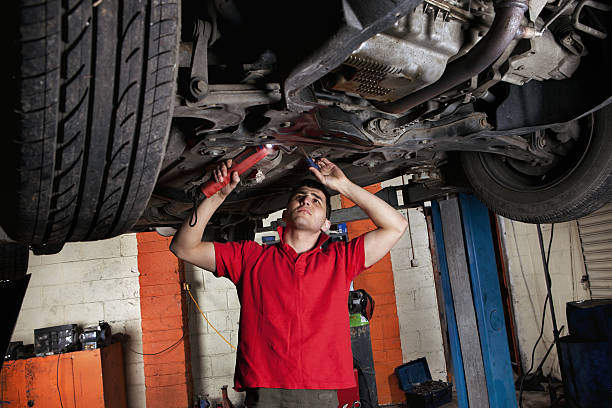
An exhaust leak is a common issue that can affect any vehicle, and detecting it early on is crucial for maintaining the performance, efficiency, and safety of your ride. Exhaust leaks can lead to a loss of power, reduced fuel efficiency, and increased emissions, as well as pose potential health risks due to the release of harmful gases. In this comprehensive guide, we’ll explore the causes of exhaust leaks, the symptoms to watch out for, and how to address this issue to keep your vehicle running smoothly and safely.
Understanding the Exhaust System and Its Components
The Role of the Exhaust System
The exhaust system plays a vital role in your vehicle’s overall performance and efficiency. It is responsible for removing waste gases, such as carbon monoxide, nitrogen oxides, and hydrocarbons, produced by the engine during combustion. By doing so, the exhaust system not only helps improve engine performance but also reduces harmful emissions and noise levels.
Key Components of the Exhaust System
To better understand exhaust leaks and their symptoms, it’s essential to familiarize yourself with the main components of the exhaust system. These include:
- Exhaust manifold: Collects exhaust gases from the engine’s cylinders and channels them into the rest of the exhaust system.
- Oxygen sensors: Monitor the levels of oxygen in the exhaust gases to help optimize the air-fuel mixture for better engine performance and efficiency.
- Catalytic converter: Converts harmful pollutants in the exhaust gases into less harmful substances before they are released into the atmosphere.
- Muffler: Reduces the noise produced by the exhaust gases as they travel through the system.
- Exhaust pipe: Carries the exhaust gases from the manifold to the muffler and eventually out of the vehicle.
Causes of Exhaust Leaks
Corrosion and Rust
One of the most common causes of exhaust leaks is corrosion and rust. Over time, the exposure to moisture, road salt, and other environmental factors can cause the metal components of the exhaust system to deteriorate, leading to holes or cracks that allow exhaust gases to escape.
Impact Damage
Exhaust leaks can also be caused by impact damage, such as hitting a pothole or debris on the road. This can lead to dents, cracks, or even punctures in the exhaust system components, resulting in a leak.
Gasket Failure
Gaskets are used to seal the connections between various exhaust system components, such as the exhaust manifold and the cylinder head. Over time, these gaskets can wear out, become damaged, or fail due to heat and pressure, leading to exhaust leaks at the connection points.
Loose or Damaged Connections
Another cause of exhaust leaks is loose or damaged connections between the various components of the exhaust system. This can occur due to normal wear and tear, improper installation, or impact damage. When connections become loose or damaged, exhaust gases can escape through the gaps.
Symptoms of an Exhaust Leak
Increased Engine Noise
One of the most noticeable symptoms of an exhaust leak is increased engine noise. If you hear a loud, rumbling, or hissing sound coming from your engine, especially during acceleration, this could be a sign of an exhaust leak. The noise may also become louder as you increase your vehicle’s speed or when the engine is under load, such as when climbing a hill or towing a trailer.
Decreased Power and Acceleration
An exhaust leak can also cause a noticeable decrease in your vehicle’s power and acceleration. This is due to the fact that exhaust leaks can disrupt the proper flow of exhaust gases, leading to reduced engine efficiency and performance. If you notice that your vehicle is struggling to accelerate or feels sluggish, especially when going uphill or carrying a heavy load, this could be a sign of an exhaust leak.
Reduced Fuel Efficiency
Another symptom of an exhaust leak is a decrease in fuel efficiency. Since exhaust leaks can impact the engine’s performance, it may require more fuel to produce the same amount of power, leading to higher fuel consumption. If you notice that you’re filling up your gas tank more frequently than usual without any changes in your driving habits, an exhaust leak could be the culprit.
Smell of Exhaust Fumes Inside the Cabin
A potentially dangerous symptom of an exhaust leak is the smell of exhaust fumes inside your vehicle’s cabin. This is a serious issue because it indicates that harmful gases, such as carbon monoxide, are entering the cabin, posing a risk to your health and safety. If you notice a strong, unusual odor inside your vehicle, it’s crucial to have the exhaust system checked immediately.
Check Engine Light Illuminated
In some cases, an exhaust leak can cause the check engine light to illuminate on your vehicle’s dashboard. This is usually due to the leak affecting the readings from the oxygen sensors, which can impact the engine’s air-fuel mixture and cause poor performance. If your check engine light comes on, it’s essential to have your vehicle inspected by a professional to determine the cause and address any issues promptly.
How to Inspect and Repair Exhaust Leaks

Visual Inspection
If you suspect an exhaust leak, one of the first things you can do is perform a visual inspection of your vehicle’s exhaust system. With your vehicle safely raised on a lift or jack stands, look for signs of corrosion, rust, or damage to the exhaust components. Also, check for loose or damaged connections and worn or damaged gaskets.
Listen for Leaks
Another way to detect exhaust leaks is by listening for them. With your vehicle running, carefully listen for any unusual noises coming from the exhaust system, such as hissing or ticking sounds. Be sure to exercise caution, as the exhaust system can become extremely hot when the engine is running.
Smoke Test
A smoke test can also be used to identify exhaust leaks. By introducing smoke into the exhaust system and observing where it escapes, you can pinpoint the location of the leak. This method should only be performed by a qualified professional, as it requires specialized equipment and knowledge.
Repairing Exhaust Leaks
Depending on the severity and location of the exhaust leak, repairs may involve patching small holes or cracks, tightening loose connections, replacing damaged gaskets, or replacing entire components of the exhaust system. In some cases, a temporary fix, such as using an exhaust repair putty or tape, may be sufficient until a more permanent repair can be made. However, it’s essential to consult with a professional mechanic to determine the most appropriate course of action for your specific situation.
Conclusion
Detecting exhaust leak symptoms and addressing them promptly is crucial for maintaining the performance, efficiency, and safety of your vehicle. By familiarizing yourself with the common causes and symptoms of exhaust leaks, as well as knowing how to inspect and repair them, you can help keep your ride in top shape and avoid potential issues down the road. Always consult with a qualified professional if you suspect an exhaust leak or need assistance with repairs to ensure the safety and longevity of your vehicle.








